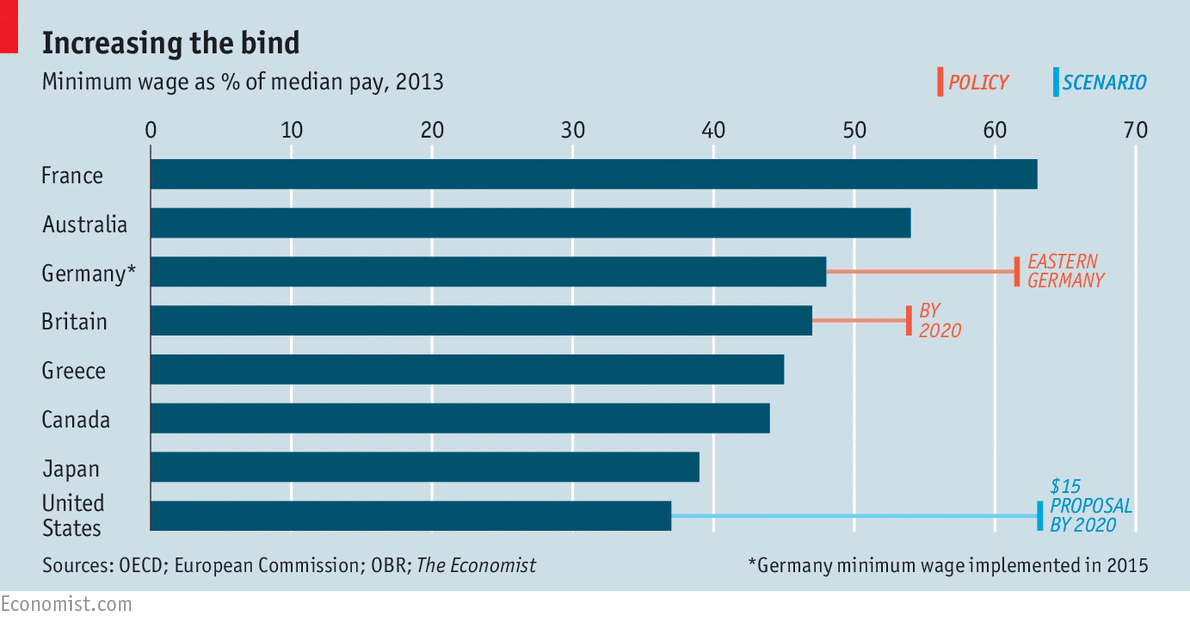
FED up with pay increasing only at a snail’s pace, politicians are resorting to the law instead, by increasing the minimum wages that businesses must pay. But this is taking them into uncharted territory. Britain’s recent minimum-wage increase will take it from the average among OECD countries to the upper ranks. Germany’s new minimum wage, introduced in January, stands at 62% of average earnings in east German states. If a $15-an-hour federal minimum wage were implemented in America, as campaigners want, it would apply to two-fifths of workers.
In the past, cash increases in the minimum wage have been eroded by inflation. America’s federal minimum wage was last set, at $7.25, in 2009 and has not been changed since, so its value has faded over time. This means that in reality most countries have only ever temporarily increased the real minimum wage. If the recently proposed increases are maintained over time (as the electorate will surely expect), there could be long-term effects. Historically, economists have worried that high minimum wages boost the pay of those in work but at the expense of jobs. Take a burger bar, which is forced to pay its employees a higher legal minimum. To avoid making a loss, it might have to raise prices, putting off customers and reducing the need for staff. A permanent increase in the minimum wage could tip the balance in favour of burger-flipping machines, away from employees. Supermarkets have already replaced many cash-till operators with self-checkout machines. Displaced workers might find different jobs, though they might struggle to do so if they are low-skilled.
The evidence seemed to support the scepticism of dismal scientists until a study in 1993 by David Card and Alan Krueger found that employment in New Jersey restaurants actually increased in response to a minimum-wage rise. This sparked a huge debate and heated criticism from two rival economists, David Neumark and William Wascher, who used different methods to show that minimum wages did indeed hurt jobs. Twenty years later, the debate is still not settled, but the sides have converged. The debate is now largely between those arguing that there are small negative effects and those who say there are none at all.
That makes higher minimum wages look like electorally popular policies; they do not require unpleasant tax rises, and do not seem to lock the poorest out of work. As a result, proposals for large increases in the minimum wage abound. Some propose tying the minimum wage to inflation or earnings, which would make the increases permanent. But three new papers suggest a more cautious approach would be more sensible.
In the first Isaac Sorkin of the University of Michigan argues that firms may well substitute machines for people in response to minimum wages, but slowly. Mr Sorkin offers the example of sock-makers in the 1930s, which took years to switch to less labour-intensive machines after the federal minimum wage was brought in. He also explains how this finding squares with other research. Most studies look at past minimum wage increases that were not inflation-proofed. Firms may decide not to go through the hassle of investing in labour-saving machines if the minimum wage will affect them less over time. But they could respond differently to a more permanent increase.
Mr Sorkin crunches the numbers, using a model of the American restaurant industry in which companies choose between employees and machines. He investigates the effect of a permanent (ie, inflation-linked) increase in the minimum wage and shows that the tiny short-run effects on employment normally seen are fully consistent with a long-run response over 100 times larger. The lack of evidence for a big impact on employment in the short term does not rule out a much larger long-term effect.
In a second paper, written with Daniel Aaronson of the Federal Reserve Bank of Chicago and Eric French of University College London, Mr Sorkin goes further, offering empirical evidence that higher minimum wages nudge firms away from people and towards machines. The authors look at the type of restaurants that close down and start up after a minimum-wage rise. An increase in the minimum wage seems to push some restaurants out of business. The eateries that replace them are more likely to be chains, which are more reliant on machines (and therefore offer fewer jobs) than the independent outlets they replace. This effect has not been picked up before because the restaurants which continue to operate do not change their employment levels, so the jobs total does not shift much in the short run.
Young, gifted and fired
The third cautionary paper is from Jonathan Meer of Texas A&M University and Jeremy West of the Massachusetts Institute of Technology. Studies typically hunt for a fall in employment in response to a minimum-wage increase. But if the increase affects the rate of growth in employment, rather than the level, differences would appear slowly over time. Standard measures would struggle to pick up this more subtle effect.
Their results suggest that a 10% increase in the minimum wage, made permanent by linking it to inflation, could cut job growth by 0.3 percentage points a year. Over a long period, this could amount to a very large difference indeed, though the authors stress that such long-run extrapolations are difficult given the limited experience of such permanent changes. Worryingly, the effects on jobs growth they see are concentrated among people under 25, and those without a degree. These are vulnerable groups who risk being locked out of the labour force for good.
The evidence so far may therefore be a poor guide to the effects of the latest wave of minimum-wage rises. Although the short-run effects seem mild, large increases could be storing up big problems for the future.

No comments:
Post a Comment